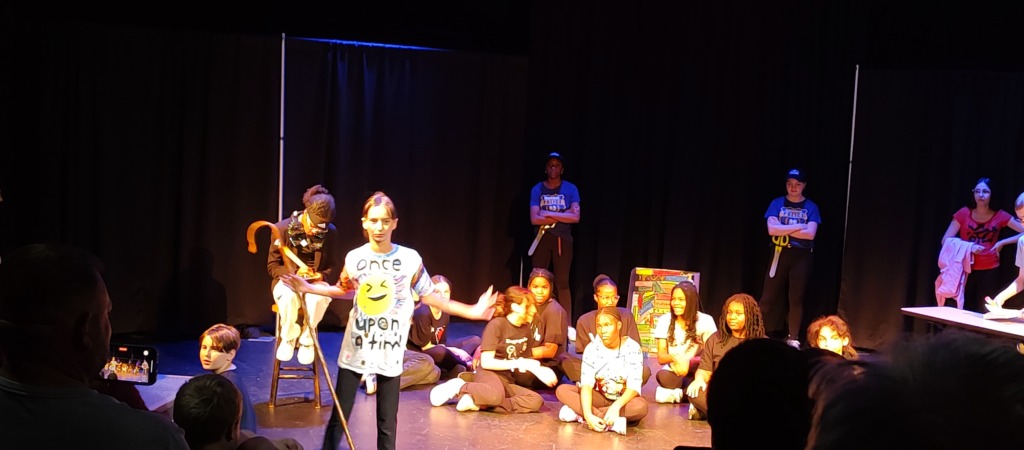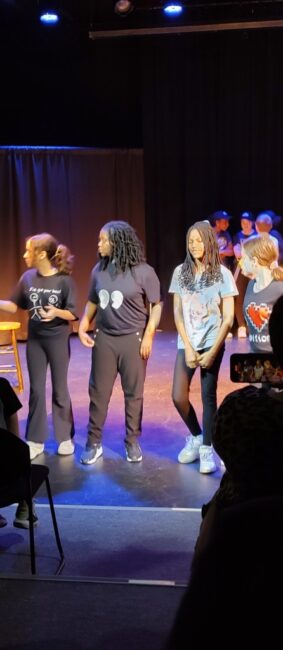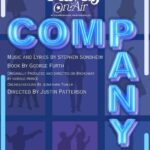The past, present, and future walked into a bar. It was tense. The sixth grade creative-writing students/acting students of Anne Arundel County Public School’s Apex Arts program might find that amusing. Just like I found their production of CJ Crowe’s Storyline to be amusing. It was certainly chuckle-worthy and well-acted, which is saying something for young students who are just starting off their arts-journey in middle school! Presented as a part of their spring showcase, which unfolded under the capable supervision of Marie Talios (Apex Arts Drama Prime teacher), on Wednesday May 14th 2025, 16 sixth graders presented this one-act-style play, which is a quirky exploration of how to write a story, showcasing their skills as actors and their understanding of the creative writing process.

CJ Crowe, the author of Storyline and the director of the aforementioned students, currently serves as an Apex Arts sixth-grade Acting Teaching Artist and is also the founding and current operations manager for Do Or Die Productions, an interactive, comedy-based murder-mystery company that partners with the Apex Arts program to teach students improv-skills, acting skills, and the art of interactive comedy. Using these techniques, Crowe has imparted vast swaths of wisdom to these sixth graders and it showed. Of the showcase pieces, these students appeared to have acting training— particularly in regards to projecting their voices and being heard. (Other grade levels were difficult to hear, speaking at conversational levels amongst themselves even when their characters were facing outward to the audience.) And although at times some of the sixth grade students were speaking a little quickly— chalk it up to being eager and anxious to showcase all of their hard work with Storyline— the majority of them were clear and concise when it came to delivering their textual lines.
It’s very clear, based on their presentation of Storyline that these young performers are being taught the importance of how to tell a story through acting, utilizing tools like characterization, body language, vocal affectation, and other such tools that engage an audience when a performance is underway. It was also impressive that all 16 students had costumes— a little tongue-in-cheek reference to the characters they were playing— like the Grammer Police or Conflict. Everyone had a shirt or whole outfit that spoke volumes about exactly who they were in the production and it aided the audience tremendously in following along with the— pardon the pun— with the storyline of Storyline.
With all the students on stage at once, the audience was treated to the notion that when a Writer (Isaiah Hammer) is trying to create an Idea (Mason Probst) for a story, there’s very little formula or reason to it. In fact, it’s much more like a scattered explosion of multiple things happening all at once. (As a creative writer and journalist— can confirm that this staging is likely exactly what the inside of my brain looks like when I’m trying to creatively contextualize something I’ve just seen on stage and transfer my thoughts into words, put them on {digital} paper and make them make sense!)
Isaiah Hammer, as Writer, is fidgety and twitchy, exasperated but wholly engaged, just like you might expect a frustrated writer to be. Mason Probst, as Idea, is bright and pops up just like ideas often do. Probst literally sneaks up on Hammer, and the humor therein isn’t lost on anybody. Probst is spunky in his portrayal of Idea, which is a perfect foil for the frenetically jittery energy that Hammer as Writer is playing with. (Do not judge my ending this sentence with a preposition. I refuse to acknowledge that Grammar Police in that way!)
Speaking of the Grammar Police (Isabella Churchill and Helen Vazquez) they have a wildly inconvenient way of jumping into the story just when Writer thinks he’s onto something! Thank goodness for Editor (Samantha Hodges) who helps clear all those misunderstandings up. Vazquez and Churchill play their parts with zeal and a lot of enthusiasm, while Hodges can be seen keeping a calmness about her when she’s engaging with other characters. Hodges is forever scribbling when not in the immediate focus of the scene— proving that an editor’s work is never done (and as an editor, trust me, I know this to be true!) Doubling up almost like thing one and thing two are Conflict 1 (Jenesis Jennings) and Conflict 2 (Kennedy Watkins) and the pair do a fine job of bickering. It’s almost like they were conceptualized to create…conflict! Both Jennings and Watkins bring attitude to their roles and it keeps the audience engaged with their characters, like any good conflict in a story should.

If you want maniacal nonsense who truly lives up to her character’s namesake— enter Foreshadowing, as played by Sofia DeSears. Just a little full of haughty airs and that “I-told-ya-so” insistence, you get quite the punch packed out of DeSears’ Foreshadowing character. She even hints that her role isn’t through when she’s forced to exit the first time! Felix Anderson, as Resolution, might just take the cake with her cheeky delivery when finally called upon. Initially misnamed as ‘Conclusion’, she smirks and takes a bow with ‘the end’ using that as a catalyst to explain why she prefers being called Resolution instead of Conclusion. Oh and there’s Action too! Played by Andrea Regan, who’s fast-talking tongue will almost make you dizzy (slowing down just a teeny-tiny bit wouldn’t hurt here just so that the brilliance of what Regan is saying can land and be absorbed by the audience as a whole) as she delves into the moving bits of the story that Writer is trying to create.
Dialogue (Maxaria Fluerimont) and Character Development (Isabella Espinoza) and Exposition (Violet Moul) all lean into their characters by using body language and tonal shift, in particularly Espinoza’s Character Development ‘stretches’ like she’s warming up for a marathon, and let’s be honest, writers out there, we know what a true race it can be to develop those characters. Her cheeky working rapport with Writer is also well-played. And if you’re looking for action— well, not that action— but physicality, you’ll get it from Hook (Lilliana Neal) who parades herself down from the house— a well-known tactic to generate surprise within your audience. You also get a lot of physicality from Christian Robinson as Descriptive Narrative, who’s toe-tapping, eyerolling impatience is hilarious once she springs out of where her character has been kept.
And that is the conclusion of this write-up.
WAIT!! Was that statement I just said— a **GASP** use of— Misdirection? Or perhaps better referred to as ‘red herring?’ Whichever you choose to call her, Isabella Jones is like a mechanical spring, bouncing up and down every time she thinks she’s about to be called upon to engage with the storyline. Of course she’s falsely insinuating that she is Descriptive Narrative, when all along she’s actually Misdirection! Her antics, both in her false-character and once the reveal is made, are excellent, particularly her tone of voice and her expressed comprehension of her particular plot device.
It’s an impressive gathering of young talent; their keen understanding of how stories work, components of how to write a story, and how to act that story out with a real earnest intensity toward character development, stage presence, and overall theatricality— without being too overly-dramatic or campy— is clearly a testament to what CJ Crowe and the Apex Arts program is teaching the as young, up-and-coming performers.



